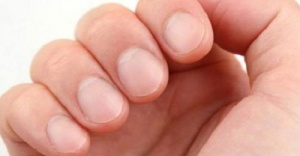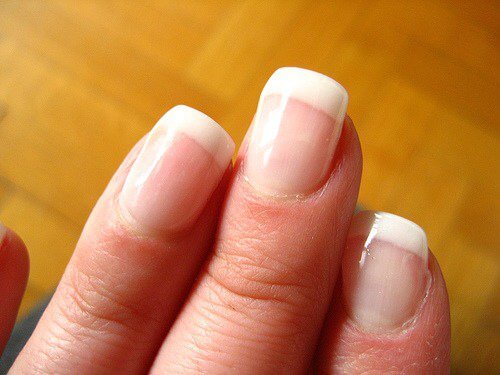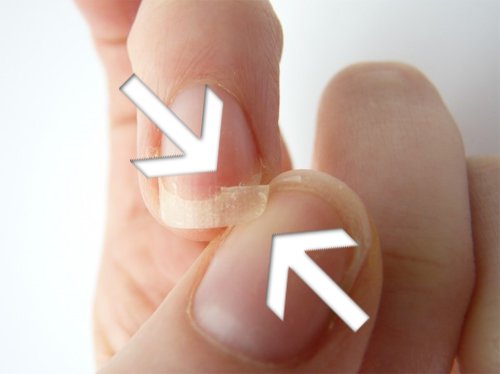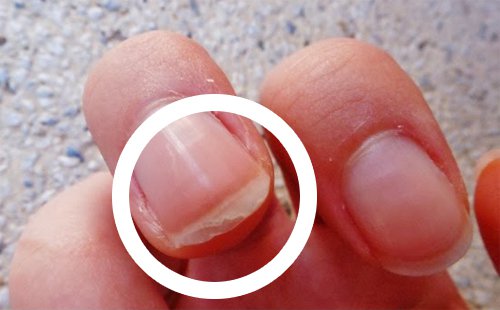8 Warning Signs Nails Give You Regarding Your Health


Reviewed and approved by the pedagogue in physical education and nutritionist Elisa Morales Lupayante
Men and women alike try their best to keep their nails looking clean and healthy. However, nails aren’t just there for looks, but can also let you know a lot about your health. They can even be the key to catching serious illnesses before it’s too late. There are a few warning signs nails can give you when it comes to other conditions you might have.
Make sure you are constantly looking at your nails to find any changes, and if you see any pay close attention because it could be a warning sign about some sort of health-related problem. Would you like to know about the different warning signs nails can give you?
Warning signs your nails could be sending about your health
Discoloured nails

- Greenish coloured nails: Green is never a good sign, check with your doctor, it could signal a bacterial infection.
- Red stripes in the nail bed: Also called splinter haemorrhages, they’re caused by a broken capillary below the nail surface. According to Medline, another cause might be a heart valve infection.
- Blue or purplish colour: As some of the more distal parts of our body, when nails in hands or feet become blue or purple, it can be a sign of low oxygen levels in the blood.
- Pale colour: When nails are too pale, it could be a sign of a vitamin deficiency or anaemia.
- White colour: When nails become completely white and the lunula isn’t visible, we’re in front of a condition called Terry’s Nail. This could be normal, but it usually is a sign of liver problems, notably cirrhosis or even congestive cardiac failure.
Thick nails
Even though thick nails are seemingly stronger, an excessive thickening of the nail is not normal at all. Thus, when nails have a claw-like appearance, are thick, or difficult to trim, it could be a warning sign of certain medical conditions.
- If the nails were normal and begin to thicken, it can be an indication of some sort of lung problem.
- When your nails not only thicken but also become rough, it is a clear sign of a fungal infection.
- If the nails are thick and *breaking apart*, you could be suffering from a thyroid problem or psoriasis.
- An unusual thickening of the nail could also be a sign of circulatory problems.
Brittle nails

- Split or broken nails can be a sign of folic acid, vitamin C, or protein deficiency.
- Broken nails could reveal poor nutrition or potentially anaemia.
- If your nails are broken and also have holes in them, it could be a sign that you suffer from psoriasis.
You might also be interested in: Treat Brittle Nails with These 5 Home Nail Remedies
Spoon-shaped nails
Concave nails, popularly known as “spoon nails”, are some of the most common warning signs your nails might be giving you. This type of nail is easily identifiable because instead of the normal outward curve nails usually grow in, your nail may grow with an inward curve. Some causes for spoon-shaped nails are:
- Anaemia.
- You may suffer from a liver condition called hemochromatosis, which occurs when the body absorbs too much iron.
- Heart problems
- Hypothyroidism
However, it’s advisable you consult with your doctor so they can double check for any of these conditions.
Scaly nails

The many layers of keratin that make up the nails give it its shiny appearance on the surface. Oftentimes, when the surface of the nail begins to flake off, it is because it has been exposed to rough activity.
- This can be a result of being exposed to a very hot, cold, or dry environment.
- It could be a reaction to certain chemicals found in some soaps or detergents.
Nails with holes in them
Holes in the nail can happen if something bumps up against it, or if you have the tendency to bite your nails. However, it can sometimes be a warning sign of a serious condition that shouldn’t be ignored. These are some common causes for this symptom:
- Psoriasis.
- A connective tissue disorder.
- Alopecia areata.
- A zinc deficiency.
As always, consult with your doctor to make sure what’s the cause for your holy nails.
Nails with white spots
White spots on the nails are a common problem when you bump or mistreat your nails. Nevertheless, they can be a sign of health problems. Besides bruises or hits taken by your nails, some of the causes for your white spots might be:
- A zinc deficiency.
- Anaemia.
Nails with ridges
Your nails should have a smooth surface with no visible lines. If lines form “ridges” of sorts, it can indicate some sort of health issue. Here are some reasons for the ridges in your nails:
- Iron deficiency.
- Inflammatory arthritis
- Lupus or other autoimmune diseases.
You might want to read: 9 reasons why your nails break
Remember!
Your nails may be a better indicator of your health than you might think. Thus, if you notice some sort of change, the best thing for you to do is go see a doctor to find out why and rule out any serious health problems.
All cited sources were thoroughly reviewed by our team to ensure their quality, reliability, currency, and validity. The bibliography of this article was considered reliable and of academic or scientific accuracy.
- Adigun, C. (2021). Síndrome de la uña verde. Manual MSD versión para público general. Consultado el 23 de julio de 2022. Disponible en: https://www.msdmanuals.com/es-es/hogar/trastornos-de-la-piel/trastornos-de-las-u%C3%B1as/s%C3%ADndrome-de-la-u%C3%B1a-verde.
- Adigun, C. (2021). Onicomicosis. Manual MSD versión para público general. Consultado el 23 de julio de 2022. Disponible en: https://www.msdmanuals.com/es-es/professional/trastornos-dermatol%C3%B3gicos/alteraciones-de-las-u%C3%B1as/onicomicosis
- Adeyinka, A. & Kondamud, N. Cianosis. Consultado el 16 de febrero de 2023. StatPearls. Disponible en: https://www.ncbi.nlm.nih.gov/books/NBK482247/
- Chang, P. (2013). Onicosquicia: informe de 20 casos. Dermatología cosmética, médica y quirúrgica, 11(4), 250-252. Disponible en: https://biblat.unam.mx/es/revista/dermatologia-cosmetica-medica-y-quirurgica/articulo/onicosquicia-informe-de-20-casos
- Cheslock, M. & Harrington, D. (2020). Yellow Nail Syndrome. StatPearls. Consultado el 16 de febrero de 2023. Disponible en: https://www.ncbi.nlm.nih.gov/books/NBK557760/#:~:text=Yellow%20nail%20syndrome%20(YNS)%20is,reported%20by%20Heller%20in%201927.
- Chessa, M. A., Iorizzo, M., Richert, B., et al. (2020). Pathogenesis, clinical signs and treatment recommendations in brittle nails: a review. Dermatology and therapy, 10(1), 15-27. Disponible en: https://www.ncbi.nlm.nih.gov/pmc/articles/PMC6994568/#:~:text=Nail%20brittleness%20is%20characterized%20by,keratin%20and%20worn%2Ddown%20nails.
- Dávila, M. E., Zorrilla, A., Memije, M. & Guzmán, R. (2019). Traquioniquia: una visión práctica. Dermatología Cosmética, Médica y Quirúrgica, 16(4), 306-309. Disponible en: https://www.medigraphic.com/cgi-bin/new/resumen.cgi?IDARTICULO=84518
- Fawcett, R. S., Linford, S. & Stulberg, D. L. (2004). Nail abnormalities: clues to systemic disease. American family physician, 69(6), 1417-1424. Disponible en: https://www.aafp.org/pubs/afp/issues/2004/0315/p1417.html#:~:text=The%20visual%20appearance%20of%20the,up%20for%20hemochromatosis%20or%20anemia.
- Iorizzo, M., Pazzaglia, M., Piraccini, B., et al. (2004). Brittle nails. Journal of cosmetic dermatology, 3(3), 138-144. Disponible en: https://onlinelibrary.wiley.com/doi/10.1111/j.1473-2130.2004.00084.x
- Iorizzo, M., Starace, M. & Pasch, M. C. (2022). Leukonychia: What can white nails tell us? American Journal of Clinical Dermatology, 23(2), 177-193. Disponible en: https://www.ncbi.nlm.nih.gov/pmc/articles/PMC8809498/
- Mayo Clinic. (2022, 20 de enero). Uñas: Problemas posibles. Consultado el 23 de julio de 2022. Disponible en: https://www.mayoclinic.org/es-es/healthy-lifestyle/adult-health/multimedia/nails/sls-20076131?s=3#:~:text=En%20general%2C%20las%20u%C3%B1as%20cuchara,una%20enfermedad%20card%C3%ADaca%20e%20hipotiroidismo.
- Sevilla, F. y Ocampo.(2011). Manifestaciones en uñas en enfermedades sistémicas. Dermatologia Cosmetica, Medica y Quirurgica, 9(2), 131-136. Disponible en: https://www.medigraphic.com/cgi-bin/new/resumen.cgi?IDARTICULO=55602
- Rathod, D. G. & Sonthalia, S. (2021). Spoon Nails. StatPearls. Consultado el 16 de febrero de 2023. Disponibilidad en: https://www.ncbi.nlm.nih.gov/books/NBK559311/
- Singh, S. K. (2013). Finger nail pitting in psoriasis and its relation with different variables. Indian Journal of Dermatology, 58(4), 310-312. Disponible en: https://www.ncbi.nlm.nih.gov/pmc/articles/PMC3726881/
- Turner, J. Parsi, M. & Badireddy, M. (2022). Anemia. StatPearls. Consultado el 16 de febrero de 2023. Disponibilidad en: https://www.ncbi.nlm.nih.gov/books/NBK499994/
- Witkowska, A. B., Jasterzbski, T. J. & Schwartz, R. A. (2017). Terry’s nails: a sign of systemic disease. Indian journal of dermatology, 62(3), 309-311. Disponible en: https://www.ncbi.nlm.nih.gov/pmc/articles/PMC5448267/
This text is provided for informational purposes only and does not replace consultation with a professional. If in doubt, consult your specialist.








